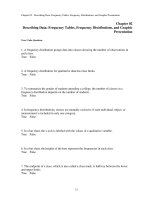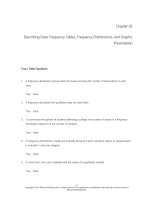Lecture Statistical techniques in business and economics - Chapter 1: What is statistics?
Bạn đang xem bản rút gọn của tài liệu. Xem và tải ngay bản đầy đủ của tài liệu tại đây (3.43 MB, 55 trang )
1 1
What is Statistics?
Copyright © 2004 by The McGrawHill Companies, Inc. All rights reserved.
1 2
When you have completed this chapter, you will be able to:
1.
2.
Explain what is meant by
statistics.
Identify the role of statistics in the development
of knowledge and everyday life.
3.
Explain what is meant by descriptive statistics
4.
Distinguish between a qualitative variable and
a quantitative variable.
and inferential statistics.
Copyright © 2004 by The McGrawHill Companies, Inc. All rights reserved.
1 3
5.
6.
7.
8.
Distinguish between a discrete variable and
a continuous variable.
Collect data from published and unpublished sources.
Distinguish among the nominal, ordinal, interval,
and ratio levels of measurement.
Identify abuses of statistics.
Copyright © 2004 by The McGrawHill Companies, Inc. All rights reserved.
1 4
9. Gain an overview of the art and science of
statistics.
We recommend that you read this chapter at least twice,
once at the beginning and once at the end of your course!
Copyright © 2004 by The McGrawHill Companies, Inc. All rights reserved.
1 5
…it is the art and science of…
collecting
What
What
is
is
Meant
Meant
by
by
Statistics?
Statistics?
Copyright © 2004 by The McGrawHill Companies, Inc. All rights reserved.
organizing
presenting data
drawing inferences
from a
sample of information
about an entire population
as well as
predicting and
developing policy analysis
1 6
in everyday life
Copyright © 2004 by The McGrawHill Companies, Inc. All rights reserved.
Who uses Statistics?
Statistics?
Who uses
1 7
Those using Statistical techniques include :
Marketers
Marketers
Economists
Economists
Sports people
Sports people
Consumers
Consumers
Statisticians
Statisticians
Quality Controllers
Quality Controllers
Politicians
Physicians
Politicians
Physicians
Accountants
Accountants
Hospitals
Hospitals
Educators
Educators
Investors
Investors
Copyright © 2004 by The McGrawHill Companies, Inc. All rights reserved.
Who uses Statistics?
Statistics?
Who uses
Weather
Forecasters
Copyright © 2004 by The McGrawHill Companies, Inc. All rights reserved.
1 8
Who uses Statistics?
Statistics?
Who uses
Sports
Copyright © 2004 by The McGrawHill Companies, Inc. All rights reserved.
1 9
1 10
Types of
Statistics
Copyright © 2004 by The McGrawHill Companies, Inc. All rights reserved.
Types of Statistics
Descriptive
Descriptive
Methods of…
collecting
organizing
presenting
and
analyzing data
Copyright © 2004 by The McGrawHill Companies, Inc. All rights reserved.
1 11
Inferential
Inferential
Science of…
Science of…
making inferences
making inferences
about a population,
about a population,
based on
based on
sample
sample
information.
information.
Identify the following…
Descriptive
Descriptive
A. A Gallup poll found that 83%
of the people in a survey knew
which country won the gold
medal in Men’s Hockey in 2002.
B. The accounting department of
a firm will select a sample of
invoices to check for accuracy of
all the invoices of the company.
C. Wine tasters sip a few drops
of wine to make a decision
with respect to
all the wine waiting to be
released for sale.
Copyright © 2004 by The McGrawHill Companies, Inc. All rights reserved.
1 12
Inferential
Inferential
The Method of
The Method of
Experimentation
Experimentation
1 13
We start off with particular observations
We start off with particular observations
from the real world and
from the real world and
draw conclusions
draw conclusions
about the general patterns in the real world!
about the general patterns in the real world!
1. Define the experimental goal or a working hypothesis
2. Design an experiment Chapters 8 and 12
3. Collect data
4. Estimate the values/relations Chapters 3 and 4
5. Draw inferences
Chapters 5,7,8 and 9
6. Predict and prepare policy analysis
Copyright © 2004 by The McGrawHill Companies, Inc. All rights reserved.
Inductive Method
Inductive Method
The Method of
The Method of
Experimentation
Experimentation
Statistical
Statistical
Techniques
Techniques
Experimental Design &
Experimental Design &
Data Collection
Data Collection
Objective
Objective
or Working
or Working
Hypothesis
Hypothesis
Copyright © 2004 by The McGrawHill Companies, Inc. All rights reserved.
1 14
Deductive Method
Deductive Method
Definitions &
Definitions &
Assumptions
Assumptions
Rules of
Rules of
Logic
Logic
Implications or
Implications or
Hypotheses
Hypotheses
1 15
A study was undertaken to estimate the
average height of penguins in Antarctica.
Let’s review the steps they would take to
prepare the estimate.
Copyright © 2004 by The McGrawHill Companies, Inc. All rights reserved.
1 16
Copyright © 2004 by The McGrawHill Companies, Inc. All rights reserved.
1 17
A population is a
collection of
all possible
individuals, objects,
or
measurements of interest
Copyright © 2004 by The McGrawHill Companies, Inc. All rights reserved.
1 18
From
Take a
…which are deemed to be representative of the
…which are deemed to be representative of the
What we now need is…
What we now need is…
Copyright © 2004 by The McGrawHill Companies, Inc. All rights reserved.
1 19
Take a
Take a
Measurement
Measurement
for each one
for each one
in the sample
in the sample
Copyright © 2004 by The McGrawHill Companies, Inc. All rights reserved.
Record
1 20
…to put the data
into a
readable and
understandable
format!
Displaying Data Results
Displaying Data Results
Copyright © 2004 by The McGrawHill Companies, Inc. All rights reserved.
1 21
Two methods that can be
used to ‘see’
what the data conveys are
Tables and
Graphs/Charts
More on these in chapter 2…
Copyright © 2004 by The McGrawHill Companies, Inc. All rights reserved.
1 22
Tables
… are an efficient method of displaying data
and depicting data accurately .
e.g.
More on these in chapter 2…
Copyright © 2004 by The McGrawHill Companies, Inc. All rights reserved.
1 23
Line
er
Scatt
Pie
Histogram
Bar
More on these in chapter 2…
Copyright © 2004 by The McGrawHill Companies, Inc. All rights reserved.
1 24
Why take a sample instead of studying
Why take a sample instead of studying
every member of the population?
every member of the population?
Costs of surveying the entire population
may be too large or prohibitive
Destruction of elements during
investigation
Accuracy of results
More in chapter 8 …
Copyright © 2004 by The McGrawHill Companies, Inc. All rights reserved.
1 25
Data are everywhere
Statistical techniques are used to make
many decision that affect our lives
No matter what your future line of
work, you will make decisions that involve
data. An understanding of
statistical
methods will help you make these
decisions more effectively.
Copyright © 2004 by The McGrawHill Companies, Inc. All rights reserved.









